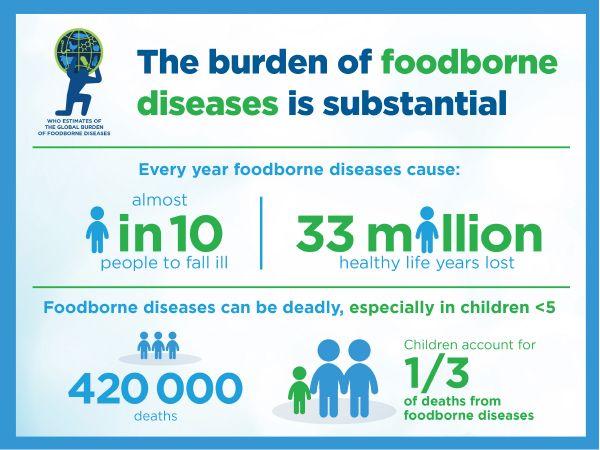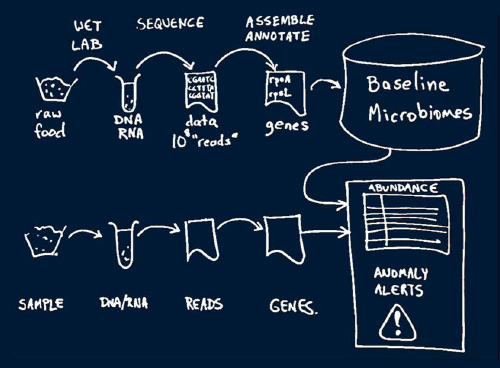Food Fight

Armed with certification programs and a collaboration platform, the Global Food Safety Initiative is battling to defend the global food supply chain from contamination.
Each year, 600 million people, or about one-tenth of the world’s population, fall ill from contaminated food. More than 400,000—including 125,000 children younger than five years old—die as a result, according to the World Health Organization (WHO).
Safety in Numbers
Technology Taste Test
To identify and implement solutions that advance food safety, the nonprofit Global Food Safety Initiative (GFSI) has brought together producers, retailers, manufacturers, and others in the food supply chain since its founding in 2000.
Around the turn of the century, multiple food safety issues across the globe damaged consumers’ trust, both in the food industry and in government’s ability to provide oversight, says Mike Robach, corporate vice president for food safety, quality, and regulatory with Cargill, a global provider of food and agricultural products, and chair of the GFSI board of directors. One such food safety issue concerns the number of reported cases of bovine spongiform encephalopathy, a progressive neurological cattle disorder in farmed cattle often referred to as mad cow disease. France saw a jump from 31 cases in 1999 to 162 in 2000, according to the World Organization for Animal Health (OIE). Ireland reported 91 cases in 1999, and 149 the next year.
GFSI’s vision: safe food for consumers everywhere. The “GFSI approach to food safety systems offers an internationally accepted certification of company or facility food safety systems, assuring that each conforms to agreed-upon, benchmarked requirements,” explains Maureen Olewnik, Ph.D., and coordinator of the Global Food Systems Initiative at Kansas State University.
While GFSI isn’t a certification program itself, it recognizes food safety certification programs (CPOs) that meet its benchmarking requirements. The CPOs “set food safety standards and develop requirements for management systems while orchestrating the certification of food operations,” according to GFSI.
As of December 2017, 19 GFSI “scopes of recognition” covered various sectors of the food industry, such as animal farming, plant farming, and food processing equipment manufacturing. “The objective is to be inclusive and cover the supply chain from farm to fork,” says Lisa Prevert, GFSI communication manager.
GFSI Trifecta
GFSI is working toward three primary objectives:
1. Harmonizing and raising the standards of food safety certification programs throughout the world by incorporating food safety standards into its benchmarking requirements. “The standards are very much science-based, very much risk-based,” Robach says. GFSI works closely with several government organizations, including OIE and the International Plant Protection Commission. Formatting agreed-upon “gold standards” for food safety so that companies can adopt them drives both consistency and safety.
2. Building food safety capacity around the world through GFSI’s Global Markets Program, which focuses on less sophisticated companies in developing markets. This is key, as the time, resources, and knowledge required to achieve certification can make it difficult for some smaller companies to pursue it.
The Global Market Program offers training and guidelines on food safety management systems, helps companies establish processes to improve food safety, and offers a path to certification. GFSI is working with regulators in some countries to implement the program, says GFSI Director Véronique Discours-Buhot.
3. Connecting with government agencies across the globe to develop joint programs. “We see this as contributing to the global harmonization of food safety regulations,” Robach says. When governments understand the food safety initiatives underway within the industry, they can better determine how to deploy their resources for oversight, he notes.
As of year-end 2017, at least 150,000 companies had been GFSI certified. Not all certification programs provide information on the companies certified, so this number likely is an underestimation, says Discours-Buhots.
Going Publix
Publix Super Markets, based in Lakeland, Florida, is among the companies that have earned certification. “Within the retail grocery industry, GFSI has become the new pre-qualification food safety component for our trading partners,” says Maria Brous, director of media and community relations for Publix.
In 2009, Publix began requiring suppliers of its private label and fresh processed foods, as well as the companies that supply ingredients to its manufacturing business unit, to complete GFSI food safety certification audits. Publix also implemented the SQF program, a GFSI certification program, in its food processing facilities.
Similarly, Cargill has had all its food facilities GFSI certified, and is driving the initiatives through its supply chain. “We’re involved in agriculture and just about every aspect of the food supply chain,” Robach says. “GFSI makes a lot of sense for us.”
To be sure, GFSI certification comes with a price tag. A company may have to modify its systems and processes, and then engage auditors to confirm that the changed systems meet CPO standards.
It’s an investment that can pay off, however. “When you improve control, there are fewer opportunities for safety issues and less waste,” says Martin Bucknavage, senior food safety extension associate with Penn State in University Park, Pennsylvania. That can cut costs and reduce the number of product refusals.
And, as more companies expect their supply chain partners to be GFSI-certified, the companies that have achieved certification may find additional business opportunities.
The Cargill Value Chain

Because it operates across many countries in a number of sectors, Cargill is involved in food safety along its entire global supply chain.
GFSI and FSMA
Indeed, one goal of GFSI since the beginning has been “once certified, recognized everywhere.” This objective can prompt a question for supply chain professionals working within the U.S. food industry, or with food companies that sell into the United States: Does GFSI certification mean a company also complies with the Food Safety Modernization Act (FSMA)?
At this point, the two acts are similar, but not identical. “If you’re GFSI compliant, you’re a long way to compliance with FSMA,” says David Acheson, M.D., president and chief executive officer with Acheson Group, a global food and beverage safety consulting company.
One subtle, but important, distinction between the two concerns the food safety plan required by FSMA. This plan describes how the company assesses and controls risks. It doesn’t need to be long, Acheson notes, but it does need to be in writing and available for FDA inspectors. GFSI currently doesn’t require a food safety plan.
That said, the “nuts and bolts of the systems you put in place for supply chain control” to earn GFSI certification overlap quite a bit with FSMA, Acheson says.
Preventing Foodborne Diseases
A Selling Point With Consumers?
Given that some companies now require their suppliers to be GFSI certified, it’s also natural to ask whether consumers might soon start requesting GFSI-labeled food. At this point, GFSI is not considering labeling consumer products. “We look at food safety as being ‘pre-competitive,'” Robach says. That is, it should be the minimum required, so all consumers can be confident their food is safe.
Problems within the food supply chain impact all companies. Rather than one company keeping best practices to itself, “it’s best for the industry to share best practices and make technology available broadly to help control any of these hazards or risks,” Robach says.
“Any time companies have to comply with a standard, it brings everything to a higher level,” Bucknavage says.
As more and more companies achieve GFSI certification, not only does the world’s food supply become safer, but all partners in the food supply chain benefit.
Safety in Numbers
The World Bank and public and private partners launched the Global Food Safety Partnership, or GFSP, in December 2012. The goal? “To promote and better coordinate food safety capacity building efforts,” says Lystra Antoine, chief executive officer.
GFSP’s approach differs somewhat from GFSI. GFSI is an industry-based organization, although it works with regulators. “GFSP brings together industry and the public sector to address issues of food safety capacity,” Antoine says.
In addition, GFSP has found the greatest need for building food safety capacity in developing countries, where upgrading food safety competencies in regulation, as well as production and processing, requires the public and private sectors to make costly investments. Both have tended to operate in silos. “The GFSP was created to address this,” Antoine says.
One example is its initiative in Sub-Saharan Africa to map food safety capacity building, with a goal of improving the targeting and coordination of actors in the region.
Technology Taste Test
Technology companies are putting their data-analysis prowess to work improving food safety. IBM, for example, is partnering with Intel and BioRad to find better ways to test food for bacteria and contaminants.
Current food testing capabilities allow scientists to test only for what they’re looking for, such as salmonella. Moreover, they must test for one thing at a time. “As the food supply chain becomes more global, the number of points where something can go wrong increases, but it’s not practical to keep adding one-off tests,” says Jeffrey Welser, vice president and lab director, IBM Research.
One potential solution is to examine the microbiome—the microorganisms inhabiting a particular environment. Once researchers identify a product’s baseline or normal biome, they’ll know to investigate any changes. “Because we’re testing the full microbiome, anything that has changed, whether on purpose or not, should show up,” Welser says.
IBM’s analytics process for food testing.
Welser and his colleagues continue to refine the software and algorithms they’re using. He expects it will be at least five years before any solution is commercially available.


